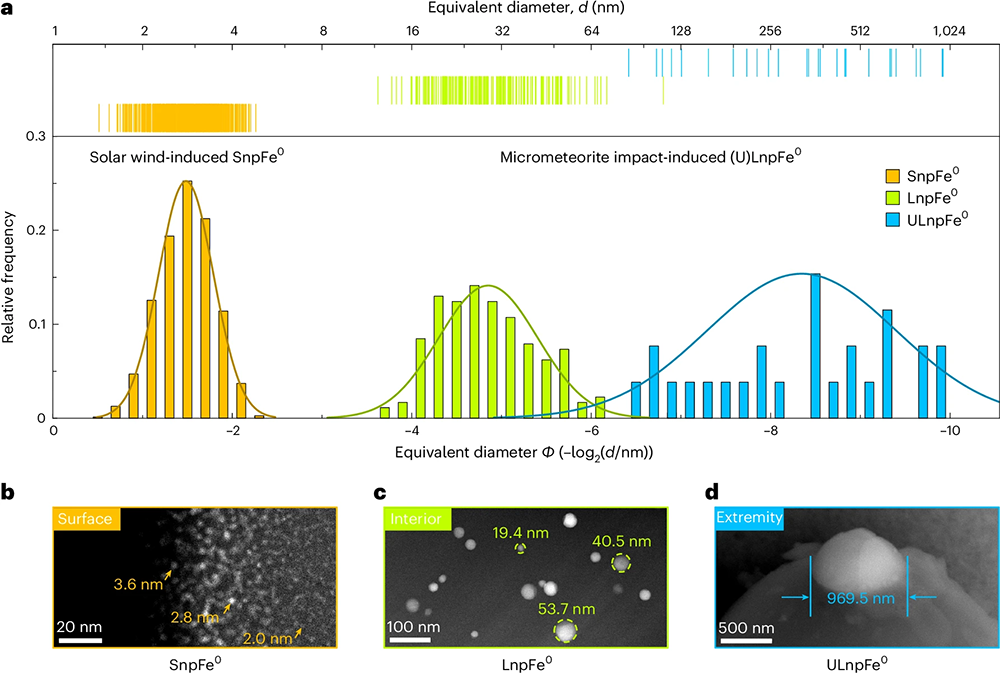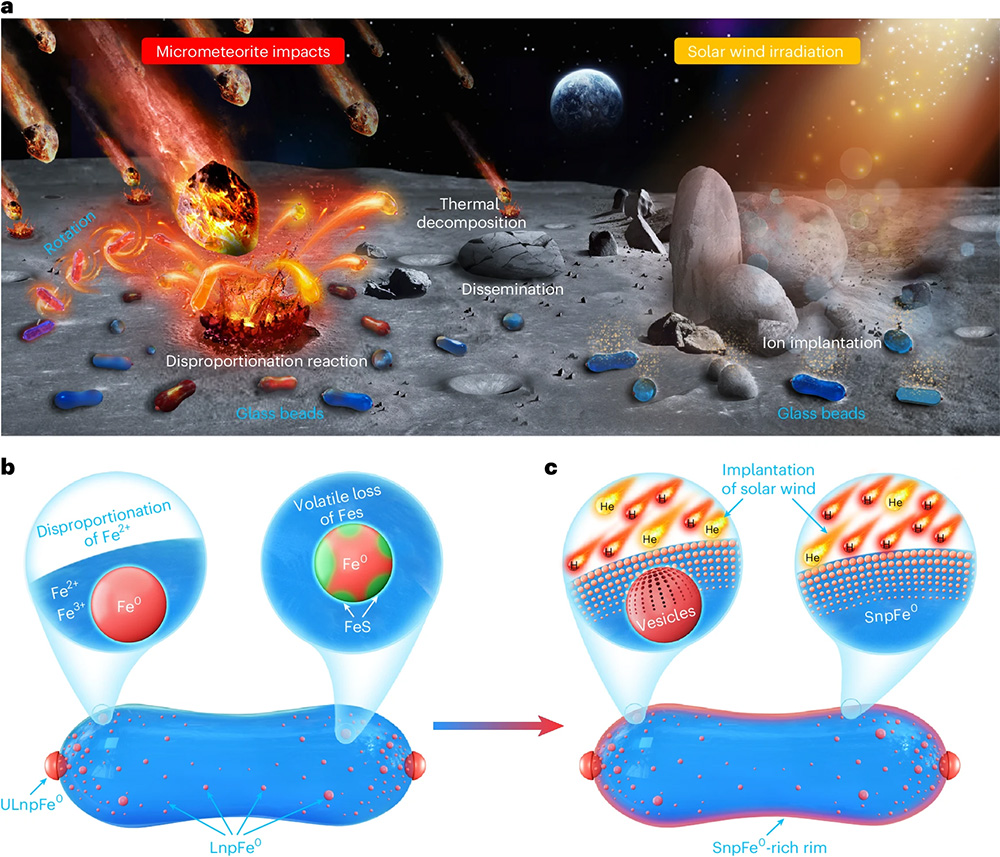Scientists clarify the origins of lunar metallic iron
Date:24-06-2024 Print
Metallic iron nanoparticles (npFe0) are widespread on the Moon, and their accumulation changes the optical spectral of the lunar surface over time. How the surface color changes largely depends on the size of npFe0: smaller npFe0 redden the reflectance spectra, while larger npFe0 cause darkening. The resultant color variations greatly complicate remote sensing studies, posing long-term puzzles to astronomers. However, the origins of npFe0 of different sizes have remained elusive.
The npFe0 are known as products of space weathering, including the two main agents: micrometeorite impacts and solar wind irradiation. Yet, the specific roles of these two agents in the formation of different-sized npFe0 have been unclear, hindering our understanding of color variations of lunar surface or asteroids under complex space environments.
Recently, Associate Prof. SHEN Laiquan, Prof. BAI Haiyang, et al. from Prof. WANG Weihua’s group at the Institute of Physics, Chinese Academy of Sciences have clarified the respective effects of irradiation and impacts on npFe0 formation. On the basis of precise observations of glass beads returned by the Chang’e-5 mission, they revealed that the formation of small and large npFe0 with distinct optical effects is independently governed by solar wind irradiation and micrometeorite impacts.
"We discovered that the glass beads in Chang’e-5 lunar soils can preserve iron particles of varying sizes, from about 1 nanometer to 1 micrometer," Prof. BAI said. “It is generally difficult to distinguish npFe0 of different origins observed together in single samples. Here, leveraging the rotation feature of impact glass beads, we clearly distinguished npFe0 formed before and after the solidification of the host glass beads.”
In this study, the scientists found numerous discrete large npFe0, tens of nanometers in size, tending to concentrate towards the extremities of the glass beads. This concentration effect can result in ultralarge npFe0 protruding out from the extremities. Such feature is exactly consistent with the migration phenomenon occurring in rotational glass-forming droplets triggered by hypervelocity impacts. In such scenarios, Fe0 with higher density than the matrix, migrate to the extremities driven by centrifugal forces, indicating that these large npFe0 formed in the impact-derived melts before the glass beads solidified.
In contrast, they also identified abundant small npFe0, several nanometers in size, densely populating the surfaces of the glass beads. These small npFe0 exhibit similar distribution features to the irradiation-induced vesicle damages. Along the depth direction of the glass beads, both small npFe0 and vesicles gradually decrease in size and abundance, corresponding to the decreasing amount of implanted solar wind ions with depth. Additionally, when the sizes of the lunar grains are comparable to twice the penetration depth of solar wind ions, small npFe0 can completely fill up the tiny grains. These findings highlight that solar wind irradiation is the primary driver of the observed small npFe0.
The study demonstrate that solar wind irradiation and micrometeorite impacts both play crucial yet distinct roles in npFe0 formation. The revealed independent growth of small and large npFe0 matches well with many remote sensing measurements, providing valuable insights for understanding and predicting the optical properties of airless bodies exposed to different space environments.
This study entitled "Separate effects of irradiation and impacts on lunar metallic iron formation observed in Chang’e-5 samples" was published in Nature Astronomy.
The study was supported by the National Natural Science Foundation of China, the Chinese Academy of Sciences, and the National Natural Science Foundation of Guangdong Province, among others.

Fig. 1 Characterizations of ULnpFe0 on extremities of impact glass beads. (Image by Institute of Physics)

Fig. 2 Size distributions of the three different types of npFe0. (Image by Institute of Physics)

Fig. 3 Schematic of space weathering on the Moon and corresponding origins of npFe0. (Image by Institute of Physics)
Contact:
Institute of Physics
BAI Haiyang
Email:hybai@iphy.ac.cn
Key word:
Space weathering; Lunar glasses; Nanophase iron particles; Micrometeorite impacts; Solar wind irradiation
Abstract:
Nanophase iron particles (npFe0) are generated on the surface of airless bodies by space weathering and can alter surficial optical properties substantially. However, the details of their formation pathways are still unclear. Here we use impact glasses returned from the Moon by Chang’e-5 to distinguish the relative contributions of solar wind irradiation and (micro)meteorite impacts to the production of different-sized npFe0. We show that solar wind irradiation can solely produce small npFe0, via implantation of solar wind ions into the topmost grain surfaces. On the other hand, (micro)meteorite impacts produce directly large npFe0 in melts, through impact-triggered disproportionation reaction or thermal decomposition. These nanoparticles are also capable to further coalesce into micrometer-sized Fe0 particles during impacts. These findings can help in predicting the space-weathering behaviour of regions exposed to different space environments.

